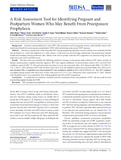| dc.contributor.author | Pintye, J | |
| dc.contributor.author | Drake, AL | |
| dc.contributor.author | Kinuthia, J | |
| dc.contributor.author | Unger, JA | |
| dc.contributor.author | Matemo, D | |
| dc.contributor.author | Heffron, RA | |
| dc.contributor.author | Barnabas, RV | |
| dc.contributor.author | Kohler, P | |
| dc.contributor.author | McClelland, RS | |
| dc.contributor.author | John-Stewart, G | |
| dc.date.accessioned | 2017-05-18T06:58:23Z | |
| dc.date.available | 2017-05-18T06:58:23Z | |
| dc.date.issued | 2017 | |
| dc.identifier.citation | Pintye, Jillian, et al. "A risk assessment tool for identifying pregnant and postpartum women who may benefit from pre-exposure prophylaxis (PrEP)." Clinical Infectious Diseases (2016): ciw850. | en_US |
| dc.identifier.uri | https://www.ncbi.nlm.nih.gov/pubmed/28034882 | |
| dc.identifier.uri | http://hdl.handle.net/11295/100948 | |
| dc.description.abstract | Background:
A human immunodeficiency virus (HIV) risk assessment tool for pregnant women could identify women who would most benefit from preexposure prophylaxis (PrEP) while minimizing unnecessary PrEP exposure.
Methods:
Data from a prospective study of incident HIV among pregnant/postpartum women in Kenya were randomly divided into derivation (n = 654) and validation (n = 650) cohorts. A risk score was derived using multivariate Cox proportional hazards models and standard clinical prediction rules. Ability of the tool to predict maternal HIV acquisition was assessed using the area under the curve (AUC) and Brier score.
Results:
The final risk score included the following predictors: having a male partner with unknown HIV status, number of lifetime sexual partners, syphilis, bacterial vaginosis (BV), and vaginal candidiasis. In the derivation cohort, AUC was 0.84 (95% confidence interval [CI], .72-.95) and each point increment in score was associated with a 52% (hazard ratio [HR], 1.52 [95% CI, 1.32-1.76]; P < .001) increase in HIV risk; the Brier score was 0.11. In the validation cohort, the score had similar AUC, Brier score, and estimated HRs. A simplified score that excluded BV and candidiasis yielded an AUC of 0.76 (95% CI, .67-.85); HIV incidence was higher among women with risk scores >6 than with scores ≤6 (7.3 vs 1.1 per 100 person-years, respectively; P < .001). Women with simplified scores >6 accounted for 16% of the population but 56% of HIV acquisitions.
Conclusions:
A combination of indicators routinely assessed in antenatal clinics was predictive of HIV risk and could be used to prioritize pregnant women for PrEP. | en_US |
| dc.language.iso | en | en_US |
| dc.publisher | University of Nairobi | en_US |
| dc.rights | Attribution-NonCommercial-NoDerivs 3.0 United States | * |
| dc.rights.uri | http://creativecommons.org/licenses/by-nc-nd/3.0/us/ | * |
| dc.subject | HIV; PrEP; postpartum.; preexposure prophylaxis; pregnancy; risk score | en_US |
| dc.title | A Risk Assessment Tool for Identifying Pregnant and Postpartum Women Who May Benefit From Preexposure Prophylaxis. | en_US |
| dc.type | Article | en_US |



